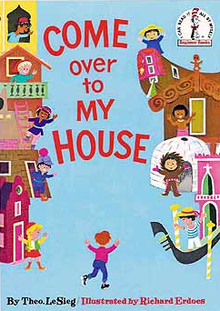 | |
| Author | Dr. Seuss |
|---|---|
| Illustrator | Richard Erdoes (original) Katie Kath (50th anniversary edition) |
| Language | English |
| Genre | Children's literature |
| Publisher | Random House |
Publication date | 1966-11-12 (renewed in 1994) |
| Publication place | United States |
| Media type | Print (hardcover) |
| OCLC | 1132492 |
| Preceded by | I Wish That I Had Duck Feet |
| Followed by | The Eye Book |
Come over to My House is a 1966 children's book written by Dr. Seuss and illustrated by Richard Erdoes. The name "Theo. LeSieg" was a pen name of Theodor Geisel, who is more commonly known by another pen name, Dr. Seuss.
The illustrations portray the various styles of homes that kids from around the world live in along with Seuss's recognizable verse. Throughout the book they also cover what kids eat, how they sleep (Japanese wooden pillows), play (sledding on pine needles), and even clean-up afterwards (Polynesian hot spring).
The book was the 44th in the Beginner Books series, in between B-43: You Will Live Under the Sea (1966) by F. & M. Phleger and B-45: Babar Loses His Crown (1967), by Laurent de Brunhoff.
Reception
[edit]In 2017, Maria Botelho of the Daily Hampshire Gazette criticized the book's images, despite the fact that Dr. Seuss did not illustrate it.[1] Botelho wrote, "in [the book], the white male protagonist travels from one stereotype about people’s dress and housing to another across the globe".[1]
References
[edit]- ^ a b Botelho, Maria José (13 October 2017). "Columnist Maria José Botelho: Dr. Seuss' books reflection of their times". Daily Hampshire Gazette.
Well, that’s interesting to know that Psilotum nudum are known as whisk ferns. Psilotum nudum is the commoner species of the two. While the P. flaccidum is a rare species and is found in the tropical islands. Both the species are usually epiphytic in habit and grow upon tree ferns. These species may also be terrestrial and grow in humus or in the crevices of the rocks.
View the detailed Guide of Psilotum nudum: Detailed Study Of Psilotum Nudum (Whisk Fern), Classification, Anatomy, Reproduction